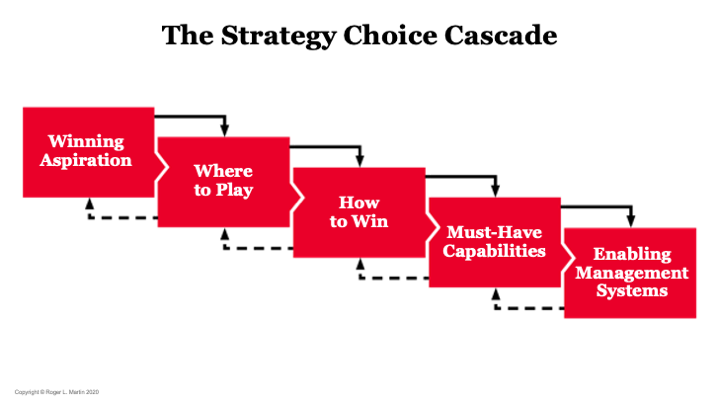Mar04

In any competitive arena, the goal is to win. It could be a sporting event, a board game, or a business venture. To achieve this goal, one needs a strategy that can guide them through the ups and downs of the game. This is where the "Playing to Win" strategy framework comes in.
The "Playing to Win" framework was developed by A.G. Lafley and Roger L. Martin, two highly respected business leaders. They wrote a book with the same title outlining the framework in detail. The book has become a go-to resource for many business leaders and sports coaches looking to develop a winning strategy.

The framework is based on five key questions every business or individual should answer before starting a new venture. These questions are:
Let us take a closer look at each of these questions.
The first question is perhaps the most critical one of all. It requires you to define what you consider a win. This could be achieving a certain level of revenue, market share, or profit margin. It could also be less tangible, like building a brand or winning a particular award.
Whatever your winning aspiration, it needs to be specific and measurable. You should also ensure that it is achievable within a reasonable timeframe. Once you have defined your winning aspiration, you can move on to the next question.
The second question is about defining the scope of your business or venture. This includes deciding which markets or customer segments you will target and what products or services you will offer. You should also consider your geographical reach and distribution channels.
To answer this question, you must thoroughly research your target markets and your competition. This will help you identify gaps in the market that you can exploit and areas where you can differentiate yourself from your competitors. Once you have defined your scope, you can move on to the next question.
The third question is about defining your competitive advantage. It requires you to identify the key drivers of success in your chosen markets and to develop a strategy that leverages your strengths while addressing your weaknesses.
To do this, you need to conduct a SWOT analysis (Strengths, Weaknesses, Opportunities, and Threats) of your business or venture. This will help you identify your core competencies and the areas where you need to improve. You can then develop a strategy that capitalizes on your strengths and addresses your weaknesses.
The fourth question concerns identifying the capabilities you need to execute your strategy successfully. This includes everything from the skills and expertise of your staff to the technology and infrastructure you need to support your operations.
To answer this question, you need to conduct a gap analysis of your current capabilities and the capabilities you need to achieve your winning aspiration. This will help you identify areas where you need to invest in training, hiring, or technology to build the necessary capabilities.
The final question defines the management systems you need to support your strategy. This includes everything from your organizational structure and decision-making processes to your performance management and incentive systems.
To answer this question, you must consider how you will align your organization around your strategy and measure progress towards your winning aspiration. You should also consider how you will incentivize and reward your staff for achieving their goals.
In conclusion, the "Playing to Win" strategy framework is powerful for developing a winning strategy in any competitive arena. By answering
the five key questions, you can create a comprehensive and actionable plan that will guide your decision-making and ensure that you are always playing to win.
It is important to note that the framework is not a one-time exercise. It should be revisited periodically to ensure your strategy remains relevant and effective. As markets and competitive landscapes change, you may need to adjust your answers to the five key questions to ensure your strategy still aligns with your winning aspiration.
The framework is also not a guarantee of success. It is only as good as the quality of your answers to the five key questions and your ability to execute your strategy. To truly play to win, you need to be willing to take calculated risks, make tough decisions, and continuously learn and improve.
Many organizations across industries, including Procter & Gamble, LEGO, and Intuit, have successfully applied the "Playing to Win" strategy framework. However, it is not limited to business applications. Individuals can also use it to develop a winning strategy for their personal and professional lives.
For example, suppose you are an athlete. In that case, you can use the framework to define your winning aspiration (e.g., winning a championship), identify the competitions and events where you will play, develop a training and competition strategy that leverages your strengths and addresses your weaknesses, identify the skills and resources you need to build, and define the management systems that will support your goals.
In conclusion, the "Playing to Win" strategy framework is a powerful and practical tool for anyone looking to achieve their goals and win in a competitive arena. By answering the five key questions, you can develop a clear and actionable strategy that leverages your strengths and addresses your weaknesses. Whether you are a business leader, an athlete, or an individual, the framework can help you achieve your winning aspirations and reach your full potential.
By Andrew Constable MBA, XPP, BSMP
Keywords: Business Strategy, Innovation, Leadership
 Breaking the External-Hire Death Spiral Before It Breaks You
Breaking the External-Hire Death Spiral Before It Breaks You 2026 Risk Mega Trends: How Ordinary Decisions Exhaust Organisational Resilience
2026 Risk Mega Trends: How Ordinary Decisions Exhaust Organisational Resilience 1x1 Relationship Building on LinkedIn
1x1 Relationship Building on LinkedIn The Resurgence of 1967 Mathematics: How DeepSeek Stabilized the AI of 2026
The Resurgence of 1967 Mathematics: How DeepSeek Stabilized the AI of 2026 The Real Question Leaders Are Asking Me About AI Isn’t Technical. It’s Human.
The Real Question Leaders Are Asking Me About AI Isn’t Technical. It’s Human.